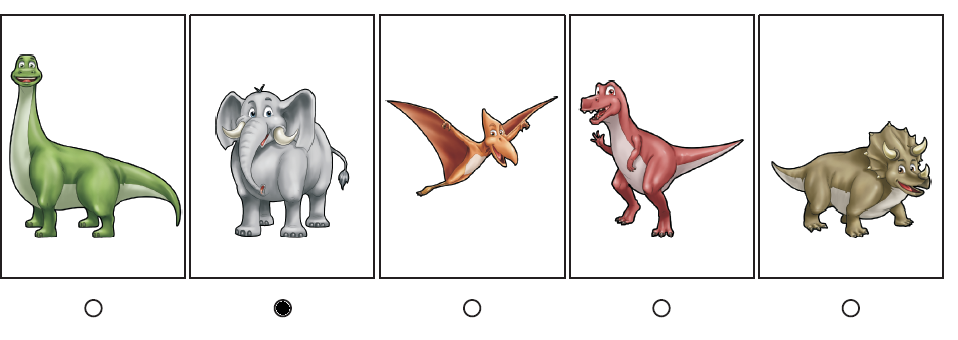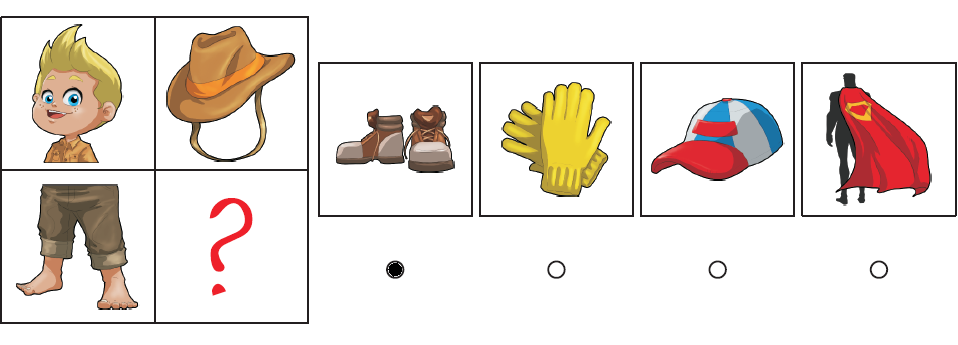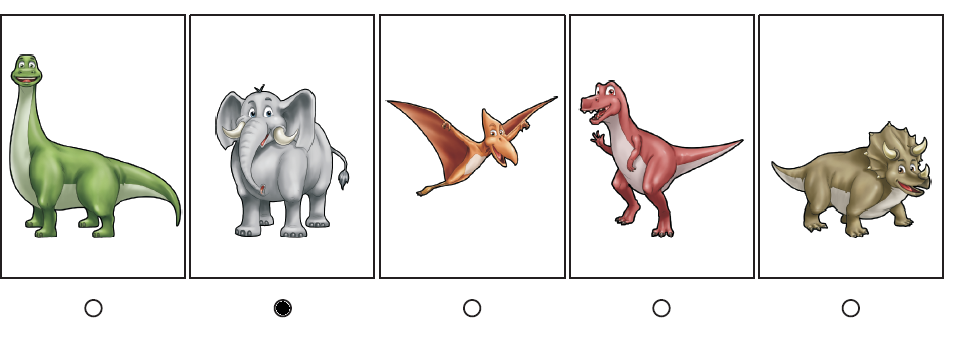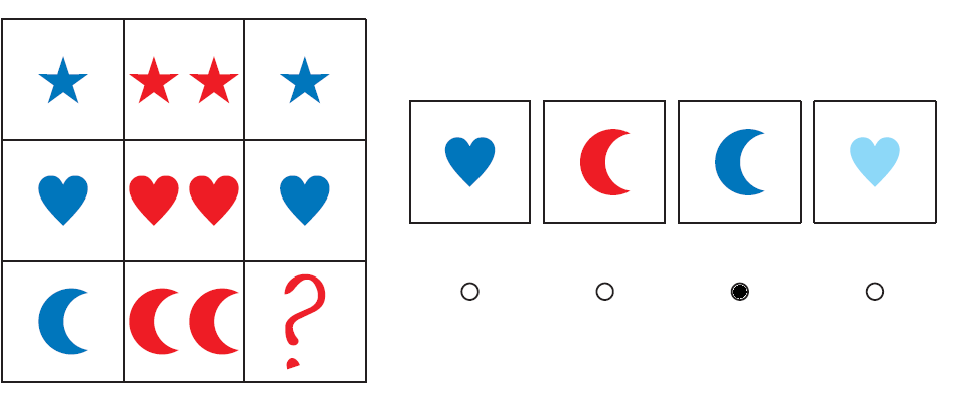OLSAT® (Otis-Lennon School Ability Test®)
About OLSAT
The Otis-Lennon School Ability Test (“OLSAT”), published by Pearson NNC, is a multiple choice test commonly used in the U.S. to identify gifted children. Schools often use the OLSAT as a tool for admission into schools and programs for gifted and talented children or to measure scholastic achievement across all ages.
Why OLSAT Mind Inventions Books?
All parents want the best for their children. Our mission is simple, we want learning to be fun, enjoyable, and stress free. We are proud to have our books recommended by teachers, approved by parents and loved by kids!
Our workbooks feature practice questions to cover both Verbal and Non-Verbal sections of the OLSAT Level A. In addition, we include stickers and fun activities to balance out the workload and make this a fun experience for the children. Most importantly all our workbooks are WIPE-CLEAN which means kids can re-do questions many times, allowing them to get better over time and save parents money from buying new books. It is no surprise our books have been ranked as best workbooks for kindergarten, best workbook for pre-k and best workbook for kids overall! It has been praised by parents, teachers and loved by kids. The activity books are fun, engaging and have a 5-star rating on Amazon. But don’t take our word for it, just look at some of the feedback we have received from thousands of happy customers.
OLSAT Overview and Facts
There are various OLSAT levels depending on students’ grade placement. The OLSAT test is presented at seven levels: OLSAT Level A for pre-k and kindergarten, OLSAT Level B for first graders, OLSAT Level C for second graders, OLSAT Level D for third graders, OLSAT Level E for fourth and fifth graders, OLSAT Level F for sixth, seventh and eighth graders, and OLSAT Level G for students from ninth through twelfth grades. Below table breaks down each level according to the grade, number of questions and time duration.
| Grade | Level | Verbal | Nonverbal | # of Questions | Time Limit |
| Pre-K | OLSAT Level A | 16 | 24 | 40 | 77 min |
| Kindergarten | OLSAT Level A | 30 | 30 | 60 | 77 min |
| 1st Grade | OLSAT Level B | 30 | 30 | 60 | 77 min |
| 2nd Grade | OLSAT Level C | 30 | 30 | 60 | 72 min |
| 3rd Grade | OLSAT Level D | 32 | 32 | 64 | 50 min |
| 4th – 5th Grade | OLSAT Level E | 36 | 36 | 72 | 40 min |
| 6th – 8th Grade | OLSAT Level G | 36 | 36 | 72 | 60 min |
| 9th – 12th Grade | OLSAT Level G | 36 | 36 | 72 | 60 min |
What Does OLSAT Test Covers?
OLSAT test is divided into two key sections: OLSAT Verbal section and OLSAT Nonverbal section. Number of questions differs depending on the students’ grade. Below is the list of detailed OLSAT sub-categories that children may encounter.
| OLSAT Verbal | OLSAT Nonverbal |
| Verbal Reasoning | Pattern Matrix |
| Aural Reasoning | Figural Series |
| Arithmetic Reasoning | Quantitative Reasoning |
| Logical Selection | Number Series |
| Word/Letter Matrix | Numeric Inference |
| Verbal Analogies | Number Matrix |
| Verbal Classification | Pictorial Reasoning |
| Inference | Picture Classification |
| Verbal Comprehension | Picture Analogies |
| Following Directions | Picture Series |
| Antonyms | Figural Reasoning |
| Sentence Completion | Figural Classification |
| Sentence Arrangement | Figural Analogies |
How is OLSAT Graded?
Points are earned for each question answered correctly and no points are lost for omitted or wrong answers. OLSAT test score is reported as a raw score which then is converted to the School Ability Index (SAI), which determines which percentile students fall into. It compares results to other children of the same age group and is dependent on how many questions were answered correctly and is then weighted against other students of the same age group. The results are reported on a scale of 0-100% and students will receive a score for the entire test as well as sub section rankings for verbal and non-verbal questions.
OLSAT score will not be available right away and will be mailed usually two months after the test.
Tips for OLSAT Test
Any test preparation starts with putting in time and effort. It is critical your child is familiar with the test and the process itself. It is important for children to practice as many OLSAT test questions as possible until they are comfortable with all sections and grasp the concepts of what is being asked. The best part about using Mind Inventions WIPE-CLEAN workbooks is that it allows children to redo the questions until they get it right.
While the actual test is given in black and white, Mind Inventions workbooks are filled with fun and colorful questions. Depending on the level, it takes about an hour to complete the test, and while doing short practice runs is helpful it is important to do a full hour practice so kids can get comfortable with the longer sessions. The test for young children in first grade and below is done with an administrator where older children take the OLSAT in a group setting. The questions during the test are read only once so it is critical that children are familiar with the OLSAT test questions.
Practice Study Habits
Before starting on any section, find a quiet place with no distractions. Make sure your child is sitting comfortably. Provide positive and encouraging feedback for correct answers and supportive feedback with explanations for incorrect answers. Avoid any negative feedback, comments, or gestures as this may discourage your child. Take breaks when necessary and make sure your child has a full tummy and a good night’s sleep.
Do not forget that for younger grades the administrator will read the question only once, so make sure that you practice with your child all question types, so they understand what to expect on the day of the OLSAT test.
Timed Practice
Make sure your child understands the concepts and the thought process of how to solve the questions. Ensure they do not spend too much time on a single question and if they get stuck encourage them to use the process of elimination and move on. Depending on the OLSAT level children have about an hour to complete the test. Practice by timing your child so they get a sense of the time it takes and make sure they don’t get stuck on one question for too long.
Process of Elimination
Many OLSAT answers can be easily narrowed down. Make sure your child looks at all the answer choices one by one very carefully. Sometimes it is useful to scan the answer choices left to right and then right to left. Be cautious as sometimes the most obvious answer choice may look to be correct but ends up being a trick answer so ensure your child does not rush.
Practice Question Formats
OLSAT tests come with many different sections of various difficulties. It is important that your child understands what to expect on the test date. Make sure to put time and effort into practice questions, especially ensure that your child understands the concepts and the thought process of how to solve the questions. Pay close attention to how your child evaluates each question and identify areas of strength and weakness. See below for additional tips in tackling various question types.
OLSAT Following Directions Overview
Following Directions and Aural Reasoning questions evaluate children’s ability to listen carefully and choose the best figural or picture representation of a description. It requires knowledge of basic vocabulary, use of logic, inference and reasoning skills. It focuses on use of prepositions, order ranking, “negative words”, arithmetic terms, and comparative terms. Some of the common words that the child should be familiar with include: “left”, “right”, “up”, “down”, “next to”, “behind”, “in front”, “under”, “below”, “above”, “on top”, “least”, “most”, “short”, “tall”, “soft”, “hard”, “slow”, “fast”, “inside”, “outside”, “on”, “off”, “between, first”, “second”, “third”, “last”, “neither/nor”, and many other similar terms.
Example:
Which picture shows a big bear in between two small mice?

OLSAT Following Direction Tips and Tricks
- Before starting on any section, find a quiet place with no distractions. Make sure your child is sitting comfortably.
- Provide positive and encouraging feedback for correct answers and supportive feedback with explanations for incorrect answers. Avoid any negative feedback, comments, or gestures as this may discourage your child.
- Before reading aloud the question, ask the child whether he is ready and to listen carefully. Preparing your child to pay attention is part of training the mind.
- Read the question slowly, if you think the child does not know what the word means, spend the time explaining. Feel free to use some simple props around the house to compare and contrast. When children see and feel objects they understand and retain the information better. Grab a bag of M&Ms, raisins or a few apples and work through some examples.
- Ask the child to review every single answer choice and eliminate wrong answers.
- Ask the child to explain the chosen answer choice and talk it out. Having children describe things helps train their mind.
- Sometimes the test questions contain content that is not relevant at all. If the child is having a hard time, consider shortening the question to the essentials and over time add back the missing pieces. The most important thing is that the child understands the concept.
OLSAT Arithmetic Reasoning Overview
Arithmetic Reasoning questions evaluate children’s ability to use numbers in order to infer relationships and solve problems. It requires understanding of simple mathematical concepts, including counting, adding and subtracting, doubling, reducing or increasing small numbers. While many questions are straightforward, some are more complicated and require careful listening and reasoning skills.
Example:
Henry and his friends are going to the beach. The first box shows some hats and sunglasses. Which picture shows how many more hats are needed so that there is an equal number of hats and sunglasses?

OLSAT Arithmetic Reasoning Tips and Tricks
- Before starting on any section, find a quiet place with no distractions. Make sure your child is sitting comfortably.
- Provide positive and encouraging feedback for correct answers and supportive feedback with explanations for incorrect answers. Avoid any negative feedback, comments, or gestures as this may discourage your child.
- Before reading aloud the question, ask the child whether he is ready and to listen carefully. Preparing your child to pay attention is part of training the mind.
- Many questions use small numbers under ten, thus if the child is just starting out with arithmetic counting it is ok to count using fingers.
- As you read the question out loud feel free to have the child capture the numbers on his hand. For example, for the question below, as soon as you read out five cookies, ask the child to make a mental note and open five fingers on his hand. As you are reading through the rest of the question, guide the child to make changes on his hand.
“Mom bought five cookies for her two sons. She gave one cookie to Mark and two cookies to Monica. How many cookies are left?”
Once the child gets comfortable counting with fingers it may longer be necessary however some of the questions are quite long and filled with unnecessary words which can confuse the child. Having a clear system in place creates a process a child can follow and depend on.
- Ask the child to review every answer choice and eliminate answers they know to be wrong.
- Incorporate Arithmetic Reasoning throughout the day. Helping the child understand the concept of increasing and decreasing along with adding and subtracting is very important for successfully answering the questions. Children are surrounded by numbers every day. Use familiar objects to help them get comfortable, such as fruits, cookies or toys.
OLSAT Picture and Figural Classification Overview
Classification questions evaluate children’s ability to identify what belongs to a group of objects, either figures or pictures. It requires knowledge of basic vocabulary and understanding of similarities and differences in order to categorize the items.
Some of the common categories that the child should be familiar with include: “size”, “shape”, “speed”, “soft/hard”, “short/tall”, “quantity”, “weight”, “color”, “cold/hot”.
Example:
Which picture does not belong?

Tips and Tricks
- Before starting on any section, find a quiet place with no distractions. Make sure your child is sitting comfortably.
- Provide positive and encouraging feedback for correct answers and supportive feedback with explanations for incorrect answers. Avoid any negative feedback, comments, or gestures as this may discourage your child.
- As the child looks through the available answer choices, ask to describe what is in the boxes. For example if the child sees a ball, add follow up questions, e.g. what color is it? What shape is it? How big is it? Do the same for every answer choice so they can recognize the patterns. It is more important for children to understand and grasp all the concepts rather than memorizing that a ball is round. Once you have discussed every box, try to guide the child into figuring out what most items have in common.
- Incorporate classification questions throughout your child’s day. Ask to categorize, what goes on the table, or what is on the dinner plate. The supermarket is an endless classification play box. Consider incorporating classification with the toys, what better way to classify cars from dolls, slow cars from fast cars, superheroes from villains, soft toys from hard toys, etc.
OLSAT Picture and Figural Analogies Overview
Analogies questions evaluate children’s ability to reason through non-verbal scenarios. The Gifted and Talented exam contains two types of analogy questions: picture analogies and figural analogies. Analogy questions are presented in a four box matrix and the child needs to identify the relationship between two pictures or figures in the first row and re-apply the same rule in the second row. Analogies are just simply another type of puzzle and can become a fun activity even after the child takes the exam.
Example:

OLSAT Picture and Figural Analogies Tips and Tricks
- Before starting on any section, find a quiet place with no distractions. Make sure your child is sitting comfortably.
- Provide positive and encouraging feedback for correct answers and supportive feedback with explanations for incorrect answers. Avoid any negative feedback, comments, or gestures as this may discourage your child.
- First, discuss the relationship in the matrix. Make sure the child pays close attention to direction, colors and changes in the boxes.
- Consider covering the answer choices and talk it out loud about possible answers.
- Ask the child to review every single answer choice and eliminate wrong answers.
- If a child is having trouble identifying a relationship, consider providing a relatable but simpler example.
- Analogies are all around us. Integrate analogies throughout the day, may it be in the morning during breakfast or in the car being stuck in traffic. There is no need to have it as a formal question. Kids love puzzles and games, help them understand the concept of analogies and they will pick it up very quickly.
OLSAT Picture and Figural Series Overview
Series questions evaluate children’s ability to predict from a sequence of pictures or figures what comes next based on an existing pattern. It requires visualization and understanding of how objects are changing across a sequence.
Similar to classification questions, children should be familiar with concepts such as: size, shape, soft/hard, short/tall, quantity, weight, color, cold/hot, speed.
Example:

OLSAT Picture and Figural Series Tips and Tricks
- Before starting on any section, find a quiet place with no distractions. Make sure your child is sitting comfortably.
- Provide positive and encouraging feedback for correct answers and supportive feedback with explanations for incorrect answers. Avoid any negative feedback, comments, or gestures as this may discourage your child.
- As the child looks through the series boxes, ask to describe what is happening. Guide the child throughout the sequence, and if he misses anything, give him some tips and hints. A triangle can be increasing in size but it can also be a specific color and point in a specific direction.
- Before moving to the answer choices, ask the child to think and visualize what could come next. It is about a way of thinking and not just about jumping to the answer choices.
- Have the child review each answer choice and describe how it relates to the sequence.
- Incorporate series questions with the child throughout the day. Ask them to sort toys by size or create patterns with M&Ms or fruits. A box of Legos is great to create endless possibilities of fun and interactive questions.
OLSAT Pattern Matrix Overview
Pattern Matrices questions evaluate children’s ability to predict a missing element based on a sequence rule. Child is shown a 3X3 matrix (9 boxes in total) with objects changing horizontally, vertically or diagonally in a sequence. The child needs to identify the sequence rule in order to fill in one empty box to complete the pattern.
Example:

OLSAT Pattern Matrix Tips and Tricks
- Before starting on any section, find a quiet place with no distractions. Make sure your child is sitting comfortably.
- Provide positive and encouraging feedback for correct answers and supportive feedback with explanations for incorrect answers. Avoid any negative feedback, comments, or gestures as this may discourage your child.
- As you read the question out loud, ask the child to look at each row in the matrix and describe what is happening. Consider the changes horizontally, vertically and diagonally. Pattern Matrices may seem intimidating for the children so take your time and break it up step by step. It is important the child is not overwhelmed with information and if anything is unclear make sure to take the time to explain the process steps.
- Guide the child throughout the sequence, and if he misses anything, ask what else is happening. A triangle can be increasing in size but it can also be a specific color and point in a specific direction. Is it moving left/right or clockwise/counterclockwise? Help the child understand and think through the process.
- Encourage the child to visualize and even draw out a possible answer choice.
- Have the child review each answer choice and describe how it relates to the sequence
What Our Customers Say
 |  |  |
| “Best education workbook for kindergarten” | Best workbooks and activity books for kindergarten” | Best kindergarten reading books for kids ages 3+” |
 |  |  |
| “Best workbooks and activity books for kindergarten” | “Best Gifted & Talented prep” | “Best NNAT-2 Activity Book” |
 |  |  |
| “Best workbooks for 1st grade” | “Best workbooks for kids overall” | “Great quality G&T activity books” |
 |  |  |
| “Best logic games” | “Best kindergarten workbooks” | “Amazing preschool learning books” |
 |  |  |
| “Best OLSAT Workbook” | “Great wipe clean early learning activity book” | “Best prep for otis lennon test and naglieri nonverbal ability test” |
 |  |  |
| “Must have early learning books” | “Fun math book” | “Best Board Games for kids” |
 |  |  |
| “Best Board Games for kids” | “Fun and engaging products for children ages 3+” | “Fun board game for kids ages 5+” |
